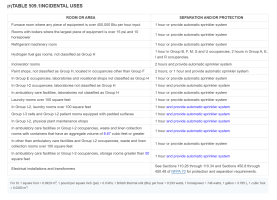-
Welcome to The Building Code Forum
Your premier resource for building code knowledge.
This forum remains free to the public thanks to the generous support of our Sawhorse Members and Corporate Sponsors. Their contributions help keep this community thriving and accessible.
Want enhanced access to expert discussions and exclusive features? Learn more about the benefits here.
Ready to upgrade? Log in and upgrade now.
You are using an out of date browser. It may not display this or other websites correctly.
You should upgrade or use an alternative browser.
You should upgrade or use an alternative browser.
Assembly Function in Business Use Group
- Thread starter dsoedharmo
- Start date
- Featured
walker.t
SAWHORSE
Wouldn’t we expect to see something under 508.2 Accessory Occupancies…508.2.3 Allowable Building Area stating an exception to the 10% limit?Why yes....yes I do...
I noticed something yesterday in a sample problem under 506.2.1 Single-Occupancy Buildings, this wasn’t so much commentary discussion as it was the use of a term I thought was misleading:Does someone have an example from the commentary that they don't agree with?
I read that and thought, “Motels have to be sprinklered with an NFPA 13R system, they can’t use an NFPA 13 system?” I concluded that “required” was a typographical error and that it should be “permitted” instead:Partial Quote of 2021 IBC Commentary on 506.2.1 Single-Occupancy Buildings (emphasis added)
Example 1:
A one-story motel, planned to be Type IIB construction. As required by the code, the building will be equipped throughout with an NFPA 13R sprinkler system.
1. It is true that R-1 occupancies must be sprinklered per 420.4.
2. 903.3.1 states that NFPA 13 sprinkler systems will be used unless otherwise permitted by 903.3.1.2 (NFPA 13R) or 903.3.1.3 (NFPA 13D.)
3. 903.3.1.2 NFPA 13R Sprinkler Systems lists three requirements that must be fulfilled for a NFPA 13R system to be used, for the sake of the example problem, we will assume those are fulfilled by the building.
4. Therefore NFPA 13R is permitted for the motel, but not required, an NFPA 13 system could also be used.
I’ve found typos in tons of books, I’m not going to give ICC too much grief for a typo - especially when I found a typo in this response which I edited out before posting it!
bill1952
SAWHORSE
I won't say I disagree. My exceptions are commentary explanations that contradict the code. Since I'm in the process of working with staff on some of this, I don't really want to post. Tomorrow I'll try to find 1 or 2 examples. And generally the items I find are in very specialized areas.
NFPA reaches out to experts in some areas for their handbook text. I don't know if ICC does or not. I may be the only expert passionate enough about it to do it for free.
NFPA reaches out to experts in some areas for their handbook text. I don't know if ICC does or not. I may be the only expert passionate enough about it to do it for free.
steveray
SAWHORSE
Because accessory is already in 508.2 and specifically limited to 10%What part of the code conflicts with the commentary concerning the no limits of such spaces that leads you to believe the commentary is wrong?
steveray
SAWHORSE
Thats picky...by code it requires suppression...The min would be an R system....Would you rather say "....at least an R system"?Wouldn’t we expect to see something under 508.2 Accessory Occupancies…508.2.3 Allowable Building Area stating an exception to the 10% limit?
I noticed something yesterday in a sample problem under 506.2.1 Single-Occupancy Buildings, this wasn’t so much commentary discussion as it was the use of a term I thought was misleading:
I read that and thought, “Motels have to be sprinklered with an NFPA 13R system, they can’t use an NFPA 13 system?” I concluded that “required” was a typographical error and that it should be “permitted” instead:
1. It is true that R-1 occupancies must be sprinklered per 420.4.
2. 903.3.1 states that NFPA 13 sprinkler systems will be used unless otherwise permitted by 903.3.1.2 (NFPA 13R) or 903.3.1.3 (NFPA 13D.)
3. 903.3.1.2 NFPA 13R Sprinkler Systems lists three requirements that must be fulfilled for a NFPA 13R system to be used, for the sake of the example problem, we will assume those are fulfilled by the building.
4. Therefore NFPA 13R is permitted for the motel, but not required, an NFPA 13 system could also be used.
I’ve found typos in tons of books, I’m not going to give ICC too much grief for a typo - especially when I found a typo in this response which I edited out before posting it!
walker.t
SAWHORSE
I personally would rather see them include references to the provisions that support their statements, something like:Would you rather say "....at least an R system"?
“The building is sprinklered as required by 420.4 using an NFPA 13R sprinkler system as permitted by 903.3.1.2.”
But the point of the sample question was to demonstrate a very simple allowable area calculation, the only information they needed to provide was that it was sprinklered with an NFPA 13R, they could have just said, “The building is sprinklered with an NFPA 13R system.”
steveray
SAWHORSE
When you cite specific code sections in other code sections it has a way of getting screwed up as codes change....If you are just speaking of explanatory material you can try to reach out to the author or ICC staff...I'm sure AI will fix it momentarily...I personally would rather see them include references to the provisions that support their statements, something like:
“The building is sprinklered as required by 420.4 using an NFPA 13R sprinkler system as permitted by 903.3.1.2.”
But the point of the sample question was to demonstrate a very simple allowable area calculation, the only information they needed to provide was that it was sprinklered with an NFPA 13R, they could have just said, “The building is sprinklered with an NFPA 13R system.”

